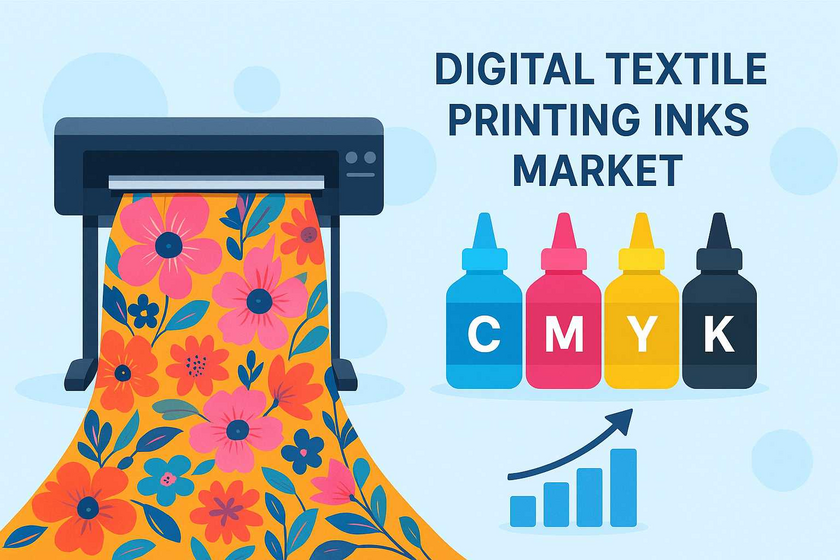The global digital textile printing inks market is experiencing remarkable growth, driven by the increasing demand for high-quality, vibrant, and sustainable printed fabrics. In 2024, the market size was valued at USD 1.87 billion, and it is projected to reach USD 4.10 billion by 2032, reflecting a robust compound annual growth rate (CAGR) of 10.28% over the forecast period from 2025 to 2032. This growth underscores the significant transformation occurring in the textile printing sector, fueled by technological advancements, rising consumer preference for customized designs, and the adoption of eco-friendly printing solutions.
Digital textile printing offers distinct advantages over conventional printing techniques, including reduced water consumption, faster turnaround times, and the ability to produce intricate and multicolored patterns with precision. These benefits have made digital inks increasingly popular among textile manufacturers seeking efficiency, creativity, and sustainability. Moreover, the growing awareness of environmental concerns and stringent regulations around water-intensive dyeing processes have prompted the industry to embrace digital printing technologies and innovative ink formulations.
The Role of Technological Advancements in Expanding the Market for Digital Textile Printing Inks
Technological innovation is a key driver in the expansion of the digital textile printing inks market. Manufacturers are investing heavily in research and development to create inks compatible with a wide range of fabrics, including cotton, polyester, silk, and blended textiles. Advanced ink formulations, such as reactive, disperse, and pigment inks, are enhancing print quality, color fastness, and fabric compatibility, thereby broadening the applications of digital textile printing across the fashion, home textiles, and industrial segments.
In addition to ink innovation, the integration of automation, precision printing, and software-driven color management systems has improved productivity and reduced operational costs for textile manufacturers. The combination of cutting-edge printing hardware and high-performance inks allows for faster production cycles, lower waste generation, and higher output quality. As a result, digital textile printing inks are increasingly being adopted by both large-scale manufacturers and small-to-medium enterprises aiming to meet evolving consumer expectations.
Rising Consumer Demand for Customization and Sustainable Fabrics Driving Market Growth
One of the most prominent trends influencing the digital textile printing inks market is the rising consumer demand for personalized and sustainable fashion. Modern consumers are seeking unique, customized designs and limited-edition clothing collections that reflect their personal style. Digital textile printing provides the flexibility to produce short-run orders and intricate patterns with minimal setup time, enabling brands to meet these demands efficiently.
Simultaneously, the textile industry is under growing pressure to adopt environmentally responsible practices. Traditional textile printing processes consume significant amounts of water and chemicals, leading to environmental degradation. Digital textile printing, on the other hand, uses less water and reduces chemical waste, aligning with global sustainability goals. This eco-friendly aspect of digital inks is not only appealing to environmentally conscious consumers but also positions manufacturers to comply with increasingly strict environmental regulations worldwide.
Regional Insights Highlighting Growth Opportunities in the Digital Textile Printing Inks Market
Geographically, the Asia-Pacific region dominates the digital textile printing inks market, driven by a strong presence of textile manufacturing hubs in countries such as China, India, and Bangladesh. The region benefits from cost-efficient production, skilled labor, and rapidly growing domestic and export demand for textile products. North America and Europe are also witnessing significant growth, particularly due to technological advancements, rising adoption of sustainable practices, and strong demand for customized and high-end textiles.
Emerging markets in Latin America, the Middle East, and Africa present substantial opportunities for market expansion. Increasing investments in textile manufacturing infrastructure, coupled with rising disposable incomes and growing awareness of digital printing technologies, are expected to fuel adoption in these regions over the coming years.
Future Outlook of the Digital Textile Printing Inks Market and Industry Implications
The future of the digital textile printing inks market looks promising, with projected growth fueled by innovation, sustainability, and consumer-centric trends. The market’s projected CAGR of 10.28% from 2025 to 2032 indicates not only the growing acceptance of digital printing solutions but also the increasing recognition of its environmental and operational benefits. As textile manufacturers continue to shift from conventional methods to digital printing, the demand for high-quality inks capable of delivering vibrant colors, fast drying times, and fabric versatility will continue to rise.
Furthermore, collaborations between ink manufacturers, printing machine producers, and fashion brands are expected to accelerate product development, enhance market penetration, and support the growth of digital textile printing as a mainstream production method. The convergence of innovation, sustainability, and customization will likely continue to reshape the textile printing landscape, offering a dynamic and lucrative growth environment for stakeholders across the value chain.
Frequently Asked Questions (FAQs) on the Digital Textile Printing Inks Market
1. What is the current size of the Digital Textile Printing Inks Market?
The market was valued at USD 1.87 billion in 2024 and is expected to grow significantly, reaching USD 4.10 billion by 2032.
2. What is the expected growth rate of the market?
The market is projected to grow at a CAGR of 10.28% from 2025 to 2032.
3. Which regions are witnessing the highest demand for digital textile printing inks?
Asia-Pacific leads the market due to its expanding textile manufacturing sector and strong demand for customized fabrics, followed by North America and Europe.
4. What are the key factors driving market growth?
Rising consumer preference for customized textiles, sustainability initiatives, technological advancements, and the growth of e-commerce in fashion and home décor are primary growth drivers.
5. How are technological innovations impacting the market?
Advancements in pigment stability, fast-drying formulations, and fabric compatibility are improving print quality and production efficiency, while research into eco-friendly ink formulations supports sustainability trends.
6. What role do consumer trends play in shaping market dynamics?
Consumer demand for personalized, fast-fashion, and high-quality textiles encourages manufacturers to adopt digital printing inks, enabling flexibility, rapid production, and creative design possibilities.


















